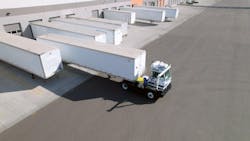Outrider Develops Autonomous Freight Yard Solution
Outrider (Brighton, CO), a robotics company focusing on sustainable, autonomous yard operations for logistics hubs, has developed a system for moving and tracking cargo trailers in distribution yards.
Distribution yards are points in the supply chain where tractor-trailers transition goods between the logistics center and the open road. In fact, they are the transition point for more than 20 billion tons of freight moving worldwide annually.
Generally, the process works like this: A commercial over-the-road semi-truck driver arrives at the yard with a loaded trailer and is checked in and directed to a parking area. The driver proceeds to that area, finds a parking space, and unhitches the truck from the container trailer, leaving the container trailer in the space. A yard crew subsequently locates that trailer, hitches it to a vehicle, known as a yard truck, which is a special-purpose semi-truck used to move the trailer around the yard. The trailer is moved to a dock to be unloaded. Once it is unloaded, it will be moved to another area for loading, then parked out in the yard, to be picked up by another commercial driver for transport to its next destination.
Yard operations typically require numerous workers to do many manual repetitive tasks, including walking or cruising the yard to locate container trailers, physically connecting and disconnecting the air lines (to engage or disengage the air brakes), and moving them to various destinations in the yard. At any given time, hundreds of trailers can be onsite, in various stages of loading or unloading. Consequently, the task of keeping track of all the trailers, 24/7, in all kinds of weather conditions, can be complicated, confusing, cumbersome and dangerous.
“Distribution yards are harsh industrial environments with around-the-clock operations,” notes Outrider Founder/CEO Andrew Smith. “Misplaced trailers, containers and chassis are a universal pain point of yard operations and over-the-road trucking.”
Another issue important to Smith and Outrider is sustainability. The vast majority of those yard trucks are powered with diesel engines, which means they are putting out heavy carbon emissions. So, in addition to automating yard operations for more safety and efficiency, Outrider also wants to slash those heavy carbon emissions by replacing diesel powered trucks with electric trucks, which have zero tailpipe emissions.
Outrider’s solution is designed to streamline and simplify the process, organize inventory tracking, and automate tasks such as locating and moving trailers within the yard—tasks that for years have been done by human workers, Smith says.
Indeed, drivers and yard staff often waste many hours searching for lost, misplaced or otherwise unaccounted for trailers, Smith notes.
“In the U.S. more than 50,000 vehicles are used to shuffle trailers between parking spaces and loading docks,” Smith says. “The yard is a busy, dangerous environment. So, the idea is to make it less dangerous—and onerous—for people working there by automating menial tasks.”
Components of the Solution
Outrider uses a robust sensor suite that includes LiDAR, radar and cameras to enable the vehicle to safely navigate through the yard, explains Londonne Corder, Outrider’s chief marketing officer. This solution includes Ouster (San Francisco, CA, USA) high-resolution LiDAR sensors for navigation and data collection, NVIDIA (Santa Clara, CA, USA) DRIVE autonomous vehicle platform for perception system processing, and Yaskawa (Waukegan, IL, USA) robotic arms, which are used for connecting and disconnecting trailer lines. Outrider installs and integrates its autonomous vehicle solution onto autonomy-ready Class 8 battery-electric yard trucks.
To track trailer inventory, Outrider’s system uses image data from camera sensors, which is fed to proprietary AI/deep learning algorithms. This vision system collects, parses and analyzes data such as empty versus occupied parking spaces, trailer identification numbers, standard carrier alpha codes—unique two- to- four-letter codes used to identify transportation companies—and other such identifying data. The AI software utilizes millions of images related specifically to yard operations.
In the past, a person with a clipboard might be able to report the whereabouts of a trailer, but that information quickly became outdated. Because the autonomous yard trucks are almost continuously traversing the yard, they can constantly collect real time data on where trailers are at a given time, giving yard management much more timely and accurate location information.
The yard truck’s data is transmitted to a control center computer, usually located and operated onsite in the distribution center, but it can also be operated remotely. Each yard manages its autonomous yard truck fleet via cloud-based management software or using its own system via API integration. All dispatching, management and orchestration can be handled by one employee.
The New Process
When over-the-road commercial semi-truck drivers check into the yard, they park and unhitch the trailer from their truck. Subsequently, a distribution yard truck, programmed to autonomously navigate through the yard, is dispatched to find and retrieve that trailer. When the yard truck finds the trailer, it backs up to and hitches to that trailer, deploys a robotic arm, which unlocks the air brakes on the trailer and connects the trailer to the yard truck, thereby enabling the trailer to be moved. There is no universal brake line connection for tractor trailers — they differ from manufacturer to manufacturer—so the robotic arms are assisted by the AI/deep learning software to correctly identify and connect to or disconnect from the trailer.
Once the yard truck transports the trailer to the loading dock, an AI/deep learning algorithm assists the truck in safely backing the trailer to an optimum position. The yard truck then disconnects the brake lines, unhitches the trailer and moves on to its next programmed destination, whether that be taking another loaded trailer back out to the yard, retrieving another trailer from the yard to be unloaded, or even navigating the yard to take inventory of the trailers at a given time.
Results
Smith says the system has been very successful in numerous beta testing situations and Outrider is in the process of putting it on the market, with plans to launch the system commercially in 2024..
While non-disclosure agreements prohibit Outrider from naming customers, Smith notes that Outrider has been working with a number of large companies, including at least one Fortune 500 company.
Georgia Pacific (Atlanta, GA, USA), an international wood products company, was identified as an early beta participant, implementing and testing Outrider’s system at one of the company’s distribution yards. A spokesperson for Georgia Pacific has confirmed that the company has been involved in a pilot project involving the Outrider system but could not provide further details. Smith also says Outrider is still working with Georgia Pacific but is unable to provide more details.
Thus far, customers have seen up to a 50% decrease in operational costs, as well as increases in safety and efficiency.
Indeed, previously, one person in an office would have to call over a radio dispatch system for an available driver, who might or might not be immediately available. Now, a yard truck can be dispatched with the click of a button, he says.
“A single person can now do the work of ten—plus drivers,” Smith says.
About the Author
Jim Tatum
Senior Editor
VSD Senior Editor Jim Tatum has more than 25 years experience in print and digital journalism, covering business/industry/economic development issues, regional and local government/regulatory issues, and more. In 2019, he transitioned from newspapers to business media full time, joining VSD in 2023.


